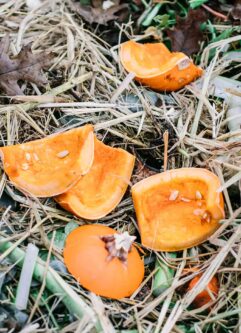How to compost a whole pumpkin
Wondering if you can toss a pumpkin in the compost pile? This guide to composting pumpkins tells you when it’s okay to compost pumpkins (and when it’s not!) and how to compost them for the best results.
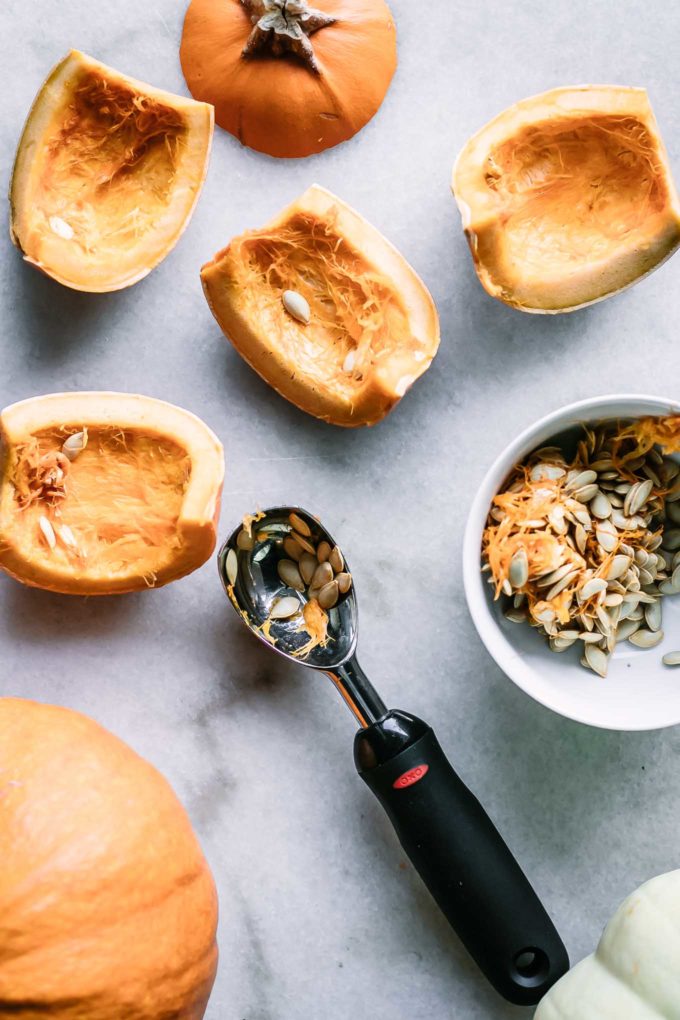
Want to Save This Recipe?
Enter your email & I’ll send it to your inbox. Plus, get new plant-based recipes in your inbox!
By submitting this form, you consent to receive emails from Fork in the Road.
Do you strive for an eco-friendly lifestyle? Us too! When it comes to sustainability, there’s so much to think about. From the types of foods you eat and cleaning products you use, all the way down to whether or not you compost a leftover pumpkin. Before you toss pumpkins in the compost pile, there are a few steps to take to take to make sure they’re safe and healthy for composting.
👉 Here is how to compost a whole pumpkin:
- Make sure the pumpkin is clean. Seeds and other non-compostable ingredients should be removed from pumpkins before composting.
- Cut pumpkin in pieces. Pumpkins should be cut into small pieces to make it easier for them to break down.
- Let pumpkin decompose in compost pile. It will take about 8-12 weeks for the pumpkin pieces to completely break down.
Before composting pumpkins, you should first become familiar with how to optimize them for the compost bin, how they decompose, and when to avoid adding them to the compost.
🔪 How to prep pumpkins for compost
Pumpkins are excellent for compost due to their high nitrogen content. They break down quickly and provide lots of nutrients for the soil. Before throwing an entire pumpkin in your compost pile, there are a few simple steps to follow.
- Remove any decorations from the pumpkin. This applies if you used the pumpkin as a Jack-O-Lantern or other means of decoration. Any candle wax should be scraped off with a metal spoon. Parts of the pumpkin that contain paint, glitter, or preserving sealant should be left out of compost, unless you know these items are biodegradable.
- Clean out the seeds. Although seeds are natural, they’re not appropriate for composting because they can take root and sprout. Instead of adding seeds to compost, set them aside and save for roasting!
- Remove the insides. If the pumpkin hasn’t started to rot, you can remove its flesh for cooking. Simply add to an airtight container and store in the refrigerator until ready to use.
- Cut the pumpkin into small pieces. Use a knife to cut the pumpkin into chunks that are about the size of your hand. The smaller the pieces, the faster the pumpkin will rot in the compost pile.
- Leave the pumpkin pieces outside for a few days (optional). If you want to break your pumpkin down even further before adding it to compost, you can leave it outside. Critters will nibble at it which will aid the decomposition process once it’s placed in the compost pile.
- Mix the pumpkin pieces with the rest of the pile. To maintain a balance of nutrients in your compost, make sure to combine the pumpkin with the rest of the ingredients rather than leaving it in one spot. You will also want to include plenty of brown material in your compost, like dead leaves, to keep the carbon to nitrogen ratio healthy.
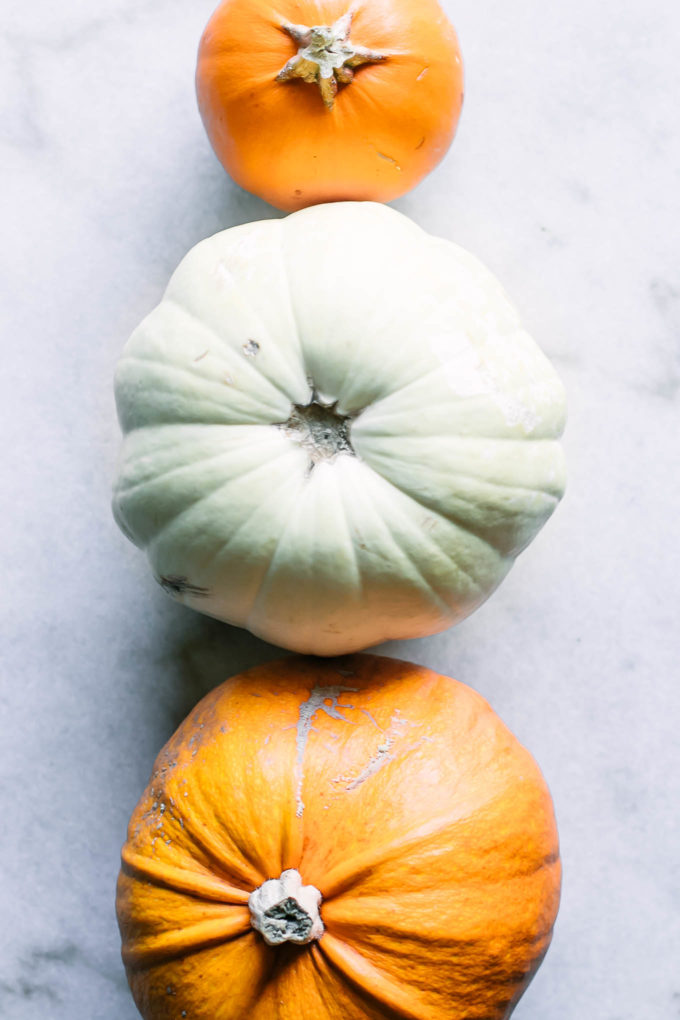
🍂 How pumpkins decompose
When pumpkins are cut from the vine, they are exposed to air and start to lose moisture, which is ultimately what causes them to rot. Due to their thick skin, it typically takes a few months before they start to decompose. Fungi, mold, bacteria, and extreme weather are other factors that can contribute to rotting.
How to tell if a pumpkin is ready to be composted
You can tell if a pumpkin is starting to decompose by the way it looks. If it has lost its bright orange color or starts to take on a dark brown color, that means the rotting process has started. When pumpkins are mushy and soft, this means they have gone bad and are ready to be composted.
How long does it take for pumpkins to decompose?
Whole pumpkins that haven’t been cut or carved take about 8 to 12 weeks to start decomposing after they are fully grown.
Once you cut a pumpkin up, it will take about 5 to 10 days to start to rot in a compost pile. Note that thicker rinds take longer to compost, so you may need to cut these into even smaller pieces.
The rotting process occurs more quickly if there’s a lot of moisture in the air or the temperature is very hot. Additionally, if you add pumpkin that has already started to rot to your compost, it will break down even faster.
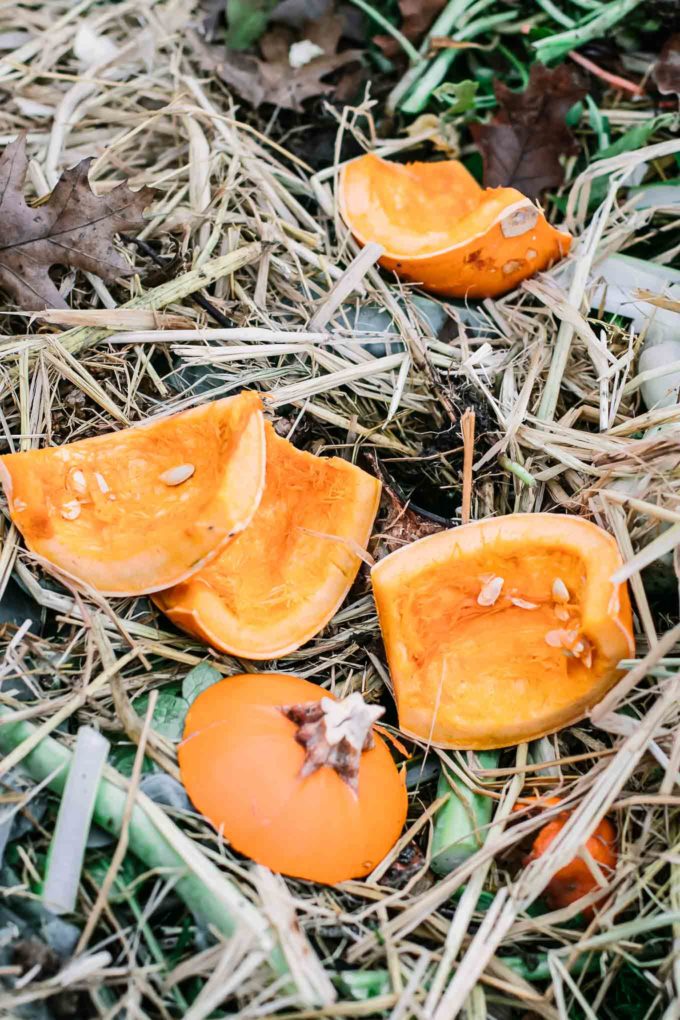
❌ Pumpkins that should not be composted
If you use pumpkins for decorations, remember that they may not be safe for compost. There are certain ingredients often used for decoration that can’t be composted, including the following:
- Paint
- Glitter
- Preserving sealant
These decorations can contaminate your compost and prevent pumpkins from rotting properly. Unless you know that the types of glitter or paint you used are biodegradable, then it is best to leave the decorated parts of the pumpkin out of compost.
You should try your best to salvage any part of the pumpkin that is not decorated, and use it for compost or cooking.
🌱 What else can you do with rotten pumpkins?
Besides using rotten pumpkins for compost, there are many other things you can do with them to avoid waste. Here are a few ideas:
- Roast the seeds. Don’t throw away pumpkin seeds! Instead, make them into a tasty snack. Simply remove from the pumpkin, wash and dry them, combine with some olive oil, salt, and pepper, and roast in the oven at 350 F for 12-15 minutes.
- Use the flesh for cooking. It’s true: the flesh inside your pumpkins is edible (as long as it hasn’t started to rot!). You can use it to make pumpkin puree, or roast pumpkin slices and enjoy as a delicious side dish. Pumpkin flesh can be added to smoothies, soup, pasta, and baked goods. Keep in mind that some types of pumpkins are better for cooking than others. We suggest trying our homemade pumpkin puree or pumpkin soup.
- Donate to a local zoo. Many zoos or wildlife retreats will accept old pumpkins as treats for their animals. Just make sure the pumpkin isn’t too rotted (this can be harmful for the animals). We suggest taking your pumpkins to the zoo no more than 5 days after you cut them up.
- Make bird feed. You can easily make bird feed by cutting the pumpkin into pieces and sprinkling bird seed on it. Pumpkins that are about 5-7 days old are ideal, as the bird seed will stick to the slices more easily.
- Bring to a farm. Some local farmers with accept firmer pumpkins as feed for their livestock. Before donating to a farm, make sure the pumpkins are just starting to become soft so they’re easy for the animal to munch on.
- Bury pumpkin chunks in your garden. This is a great way to enrich the soil, making it healthier for growing any type of produce or flowers.
- Add them to your garden or yard waste bin. As a last resort, you can have your pumpkins collected with the rest of your yard waste. Keep in mind that not all cities allow this. If you’re not sure how to dispose of your pumpkins, contact your local recycling center.
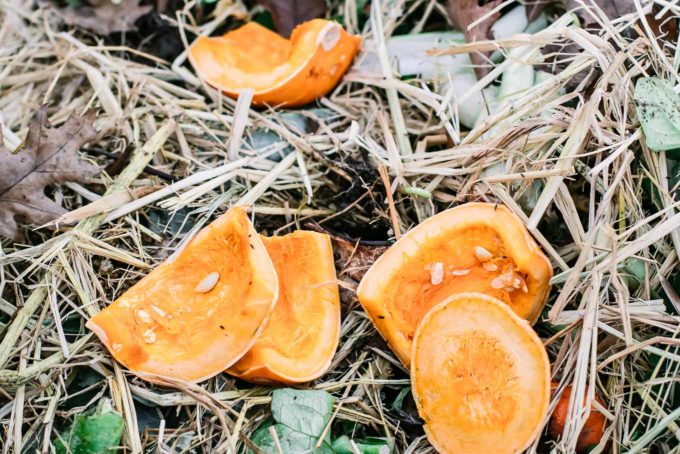
♻️ More zero waste kitchen + composting tips
Ready to take your green lifestyle to the next level? We’ve got you covered! Check out these sustainable kitchen guides:
- Zero Waste Kitchen Start Guide
- How to Clean Glass Jar Labels (Eco-Friendly Method)
- How to Remove Wine Bottles Labels Naturally
- The Ultimate Guide to Composting Paper Towels
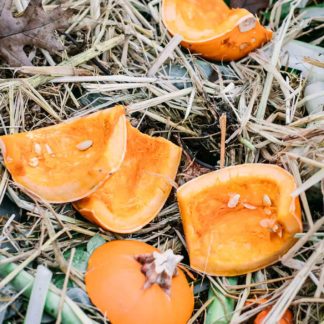
How to Compost a Whole Pumpkin
Equipment
- Large knife
- Ice scream scoop, or large spoon
- Compost bin
Instructions
- Remove any decorations from the pumpkin. This applies if you used the pumpkin as a Jack-O-Lantern or other means of decoration. Any candle wax should be scraped off with a metal spoon. Parts of the pumpkin that contain paint, glitter, or preserving sealant should be left out of compost, unless you know these items are biodegradable.
- Clean out the seeds. Although seeds are natural, they're not appropriate for composting because they can take root and sprout. Instead of adding seeds to compost, set them aside and save for roasting!
- Remove the insides. If the pumpkin hasn't started to rot, you can remove its flesh for cooking. Simply add to an airtight container and store in the refrigerator until ready to use.
- Cut the pumpkin into small pieces. Use a knife to cut the pumpkin into chunks that are about the size of your hand. The smaller the pieces, the faster the pumpkin will rot in the compost pile.
- Mix the pumpkin pieces with the rest of the pile. To maintain a balance of nutrients in your compost, make sure to combine the pumpkin with the rest of the ingredients rather than leaving it in one spot. You will also want to include plenty of brown material in your compost, like dead leaves, to keep the carbon to nitrogen ratio healthy.
Notes
- How to tell when a pumpkin is ready to be composted: You can tell if a pumpkin is starting to decompose by the way it looks. If it has lost its bright orange color or starts to take on a dark brown color, that means the rotting process has started. When pumpkins are mushy and soft, this means they have gone bad and are ready to be composted.
- Length of time to decompose: Once you cut a pumpkin up, it will take about 5 to 10 days to start to rot in a compost pile. Note that thicker rinds take longer to compost, so you may need to cut these into even smaller pieces.

